NASA's James Web Telescope successfully deploys its 70-foot sunshield that will protect the $10 billion device's scientific instruments at temperatures under -380F
NASA's James Web Space Telescope has fully deployed its massive 70-foot sunshield while it hurls through space on a journey to what is known as the Earth-sun Lagrange Point 2 (L2), which is nearly a million miles from Earth.
'All five layers of the sunshield are fully tensioned,' said an announcer at 11:59am ET at the observatory's control center in Baltimore, where team members cheered.
It took just one and a half days to tighten the ultra-thin layers using motor-driven cables, half the expected time.
The sunshield – about the size of a tennis court at full size – was folded to fit inside the payload area of an Arianespace Ariane 5 rocket's nose cone prior to launch, which took place on Christmas Day.
The shield is designed with small plastic sheets, each of which are about as thin as a human hair and coated with reflective metal, providing protection on the order of more than SPF 1 million.
The five-layered sunshield will protect the telescope from the light and heat of the sun, Earth and moon, but keeping its scientific instruments below -380 degrees Fahrenheit.
Scroll down for video

NASA's James Web Space Telescope has fully deployed its massive 70-foot sunshield while it hurls through space on a journey to what is known as the Earth-sun Lagrange Point 2 (L2), which is nearly a million miles from Earth
Thomas Zurbuchen, associate administrator for NASA's Science Mission Directorate at the agency's headquarters in Washington, said in a statement: 'This is the first time anyone has ever attempted to put a telescope this large into space.
'Webb required not only careful assembly but also careful deployments. The success of its most challenging deployment – the sunshield – is an incredible testament to the human ingenuity and engineering skill that will enable Webb to accomplish its science goal.'SHARE THIS ARTICLShare
The tightening of the sunshield was set for January 2, but was delayed by NASA to ensure it was in 'prime condition' before it is tightened.
Webb launched on Christmas Day, following several days throughout its progress that had some fearing to would never leave Earth.

The shield is designed with small plastic sheets, each of which are about as thin as a human hair and coated with reflective metal, providing protection on the order of more than SPF 1 million

It is hoped that the observatory, a replacement for the 30-year-old Hubble telescope, will by travelling so far out be able to peer back in time 13.5 billion years – to a point within a mere 100 million years of the Big Bang
It is hoped that the observatory, a replacement for the 30-year-old Hubble telescope, will by travelling so far out be able to peer back in time 13.5 billion years – to a point within a mere 100 million years of the Big Bang.
At 7:20am ET the world's most powerful space telescope, equipped with an Ariane 5 rocket, took off from the European Spaceport facility in French Guiana in magnificent form before blasting skywards over the Atlantic Ocean.
Cheers were on pause for another nerve-wracking 27 minutes as the rocket ejected its boosters and soared to an altitude of 870 miles before finally detaching the telescope to begin its own journey.

The sunshield – about the size of a tennis court at full size – was folded to fit inside the payload area of an Arianespace Ariane 5 rocket's (pictured) nose cone prior to launch, which took place on Christmas Day

Tuesday's milestone was no simple feat it involved 139 of Webb's 178 release mechanisms, 70 hinge assemblies, eight deployment motors, roughly 400 pulleys, and 90 individual cables totaling roughly one quarter of a mile in length to pull off the unraveling of the shield
With its liftoff, a spokesperson for NASA said, 'Webb will usher in a new era of astronomy'.
And four days later, Webb began the unfolding its massive sunshield.
Now it is about halfway to the L2, an area of balanced gravity between the sun and the Earth, where it will spend more than a decade exploring the universe in infrared.
Tuesday's milestone was no simple feat it involved 139 of Webb's 178 release mechanisms, 70 hinge assemblies, eight deployment motors, roughly 400 pulleys, and 90 individual cables totaling roughly one quarter of a mile in length to pull off the unraveling of the shield.
Hillary Stock, a sunshield deployment specialist for Northrop Grumman, told reporters on a call: 'It was a wonderful moment. There was a lot of joy, a lot of relief.'

Jim Flynn, sunshield manager at Northrop Grumman, NASA's primary contractor for Webb, said in a statement: 'The sunshield is remarkable as it will protect the telescope on this historic mission.
'This milestone represents the pioneering spirit of thousands of engineers, scientists, and technicians who spent significant portions of their careers developing, designing, manufacturing, and testing this first-of-its-kind space technology.'
Webb still has another five months worth of setup before it is ready to explore the universe.
This includes deployment of the secondary mirror and primary mirror wings, alignment of the telescope optics, and calibration of the science instruments.

No comments: